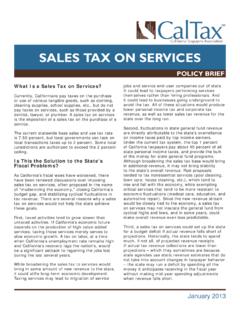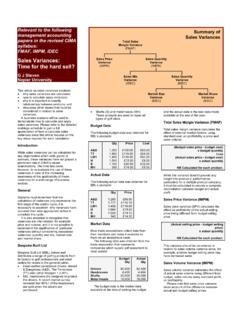Transcription of History and Economic Impact William F. Fox Professor of ...
1 History and Economic Impact William F. Fox Professor of Economics University of Tennessee March 13, 2002 This chapter focuses on two basic issues, the History and the Economic Impact of sales taxes. The chapter is divided into five sections. The first is a brief review of sales taxes and their implementation throughout History . The second discusses the general sales tax s role in current state government finance. The third is an examination of the sales tax as a consumption tax, and the other means of taxing consumption. The next section addresses trends in the sales tax base and the factors that have been altering the base. The final section is a discussion of the likely direction of sales taxes in the future.
2 1. Sales Tax History The imposition of transactions taxes can be found through much of modern civilization (see Buehler, 1940). Tomb paintings depict tax collectors in Egypt at least as early as 2000 BC, and sales taxes on individual commodities, such as cooking oil, can be traced to that time. Egypt, Athens, and Rome were all known to have general sales taxes. Indeed, the Romans were responsible for taking sales taxes to the rest of Europe, including to both Spain and France. Later, Spain had a national sales tax in place from 1342 until the 18th century, with rates that ultimately reached 10 to 15 percent. Specific commodity taxes were so broadly imposed during the civil war, that when combined, they nearly formed a general sales The use of sales taxes by states dates back at least to the Pennsylvania mercantile license tax that was initially introduced in 1821, though this and other early taxes were not broad-based.
3 Buehler attributes development of modern state sales taxes to the depression era. He credits Kentucky with the first tax levied exclusively on retailers. The initial tax, passed in 1930, was progressive, but was replaced in 1934 with a 3 percent flat rate tax and then was eliminated in 1936. The current Kentucky sales tax was adopted in 1960. Commerce ClearingHouse credits Mississippi with the first sales tax, in 1930. Forty-five states and the District of Columbia currently impose sales taxes (see Table 1). Twenty-four of the states first levied the tax during the 1930s, six in the 1940s, five in the 1950s, and eleven in the 1960s. In 1969, Vermont was the last state to impose a sales tax.
4 Alaska, Delaware, New Hampshire, Montana and Oregon do not levy general sales taxes. 1 Two characteristics normally distinguish general sales taxes from selective sales taxes. First, general sales taxes have a broad base, including a wide variety of goods and potentially of services. Second, general sales taxes are imposed at ad valorem rates and selective sales taxes are often, though not always, levied at specific rates. Cigarettes, alcohol, and gasoline are examples of goods normally taxed at specific rates but cigars and other tobacco products are often taxed at ad valorem rates.
5 1 Table 1. Date of Adoption of General Sales Tax State Year State Year Alabama 1936 Missouri 1934 Arizona 1933 Nebraska 1967 Arkansas 1935 Nevada 1955
6 California 1933 New Jersey 1966 Colorado 1935 New Mexico 1933 Connecticut 1947 New York 1965 District of Columbia 1949 North Carolina 1933 Florida 1949 North Dakota 1935 Georgia 1951 Ohio 1934 Hawaii 1935 Oklahoma
7 1933 Idaho 1965 Pennsylvania 1953 Illinois 1933 Rhode Island 1947 Indiana1 1933 South Carolina 1951 Iowa 1933 South Dakota 1933 Kansas 1937 Tennessee 1947 Kentucky 1960
8 Texas 1961 Louisiana 1938 Utah 1933 Maine 1951 Vermont 1969 Maryland 1947 Virginia 1966 Massachusetts 1966 Washington 1933 Michigan 1933 West Virginia 1933 Minnesota 1967 Wisconsin 1961 Mississippi 1930
9 Wyoming 1935 1 Gross income tax. In 1963, Indiana enacted a 2% retail sales and use tax. Source: Advisory Commission on Intergovernmental Relations, Significant Features of Fiscal Federalism, Volume 1. Budget Processes and Tax Systems, February 1993. 2. Role of Sales and Use Taxes in Government Finance State sales taxes raised $ billion in 1999 while local sales taxes raised an additional $ billion, for combined collections of $ billion. The combined sales tax collections represented percent of personal income in 1999, about the same percentage that was raised through most of the decade.
10 A longer term look shows state sales taxes rising as a share of personal income during the 1960s through 1980s, but stabilizing during the 1990s (see Figure 1). 2 FIGURE 1 General Sales Taxes as a Percent of Personal Income, Selected The sales tax was the largest source of state government finance from 1970 until 1998 when it was supplanted by the personal income tax (see Figure 2). Still, the sales tax provides nearly one-third of state government finance and ranks second to the income tax in importance as a source of state finance. Reliance on the sales tax varies widely by state. Sales taxes are much more important in the south and west than in New England and the industrial Midwest (see Figure 3).



